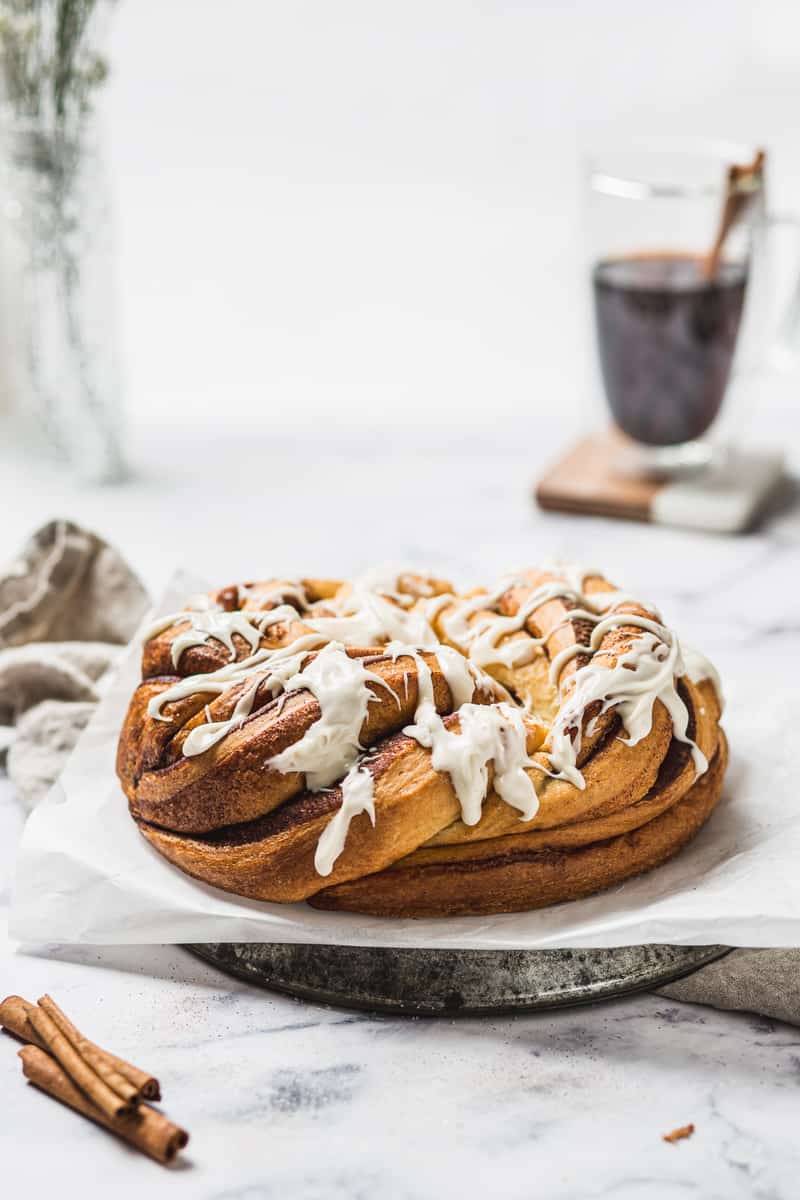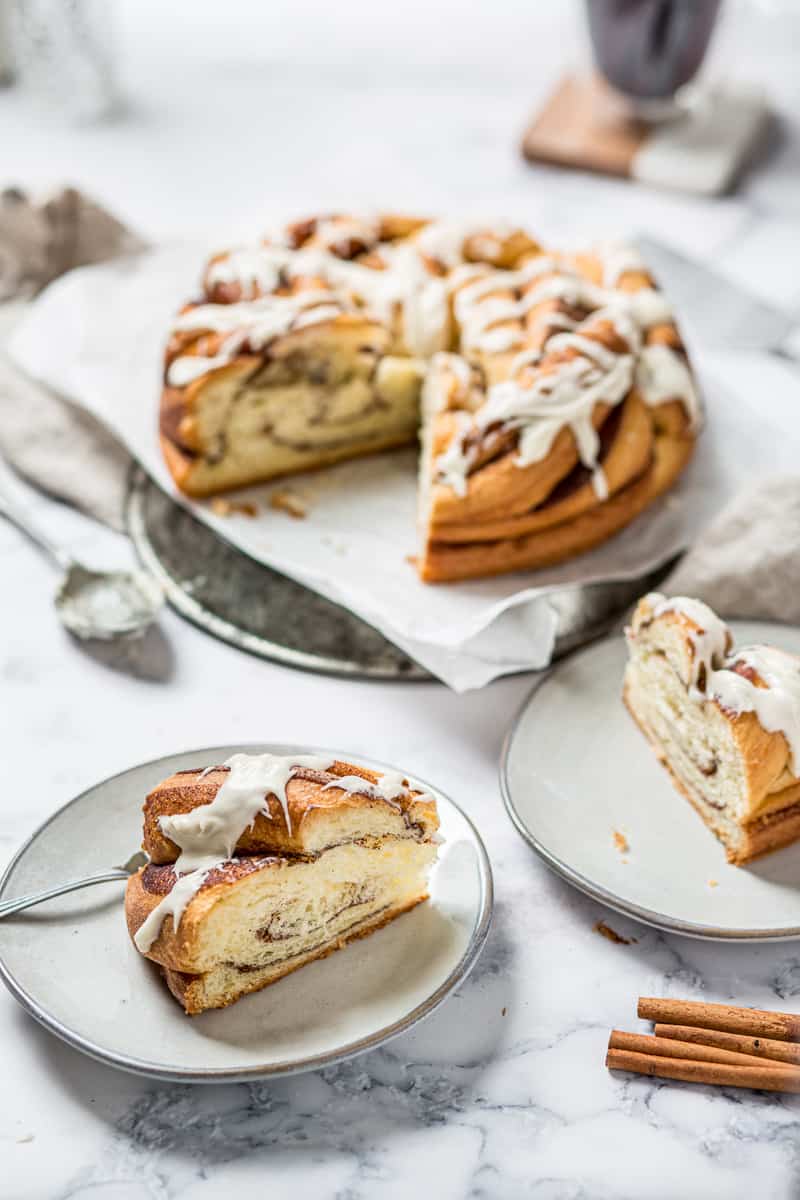When I'm getting the itch to make something really ambitious, I know I can always turn to one of Rose Levy Berenbaum's cookbooks. This Sugar Rose Brioche is a cinnamon dream adapted from The Baking Bible, and it tastes as good as it looks. It's more light and airy than a cinnamon bun, but with a rich cinnamon and butter flavor from the brioche dough.

This recipe is definitely on the complicated side, but all I can say is that it's worth it! 🙂 The general idea behind this loaf is to make a brioche dough, which is a buttery yeasted dough. Once it proofs overnight, you roll it out evenly. Then, you brush on a beaten egg, and sprinkle cinnamon sugar all over.
Once the cinnamon sugar is on, you roll it into a log, and cut the log in half longways. Then you can twist the two half-logs together and shape it into this braided round in a cake pan. Let it rise again until it fills the pan, and bake until golden on top.

After baking, I added a simple powdered sugar glaze for some extra sweetness. The glaze is just powdered sugar, water and a touch of vanilla, thinned out until it gets to the consistency that you like. Mine was on the thick side, but you can experiment. If it's thinner than mine, you might want to use a pastry brush to coat everything and make it shiny.

I definitely recommend finding Rose's recipe in The Baking Bible, or access it on the CBCK website. The recipe below is adapted from hers, and I've tried to keep it as simple as possible, assuming you know a bit about baking already. Hers is much more detailed and specific, which will help you get it right even as a beginner.
Have you ever made brioche before? My family actually loves it as hamburger and hot dog buns (without the cinnamon, of course). I know, so extra.
📖 Recipe

Sugar Rose Brioche
Equipment
- Stand mixer - not totally required, but really helpful
- 10" round springform pan
Ingredients
Yeast Starter
- 60 g water, room temperature (¼ cup)
- 26 g sugar (2 Tbsp)
- 142 g flour (1 cup plus 2 Tbsp) - Rose recommends a flour with about 12% protein content
- ½ teaspoon instant yeast
- 2 eggs
Dough (First Stage)
- 312 g flour (2 ¼ cup plus 2 Tbsp) - 12% protein content flour
- 50 g sugar (¼ cup)
- 8 g yeast (2 ½ tsp)
- 6 g salt (1 tsp)
Dough (Second Stage)
- 4 eggs
- 2 sticks butter, room temperature, cut into tablespoon size pieces (226 g)
Cinnamon Filling
- 1 egg, room temperature
- pinch fine grain salt
- 67 g caster sugar (superfine) (⅓ cup) - If you can't get superfine sugar, blitz regular sugar in a blender or food processor
- 13 g ground cinnamon (6 Tbsp)
Vanilla Glaze
- 125 g powdered sugar (1 cup)
- 1 teaspoon vanilla extract
- 113 g water (4 oz) - Add more water for a thinner icing. You can also use milk or cream here.
Instructions
Starter
- Add the water, sugar, flour, yeast and eggs to the bowl of a stand mixer fitted with the whisk attachment. Beat 2 minutes on medium speed.
- Cover the bowl and allow to rest while you do the next step. You can take out and clean the whisk attachment at this point.
Dough (First Stage)
- Whisk the flour, sugar, yeast and salt until combined.
- Sprinkle the dry flour mix on top of the starter mixture in an even layer.
- Cover the bowl with an airtight cover and allow to ferment for 1 hour. After that, either ferment for another hour at room temperature, or you can move the bowl to the fridge and let it ferment for up to a day. It's ready when the starter is bubbling through the flour coating.
Dough (Second Stage)
- Fit your stand mixer with the dough hook. Place the mixing bowl in the mixer, add the eggs and beat on medium for about 8 minutes, scraping down the sides as needed.
- While the mixer is running, add the butter one piece at a time. Wait to add the next piece until the previous one is fully incorporated.
- Coat a large bowl with grease or nonstick spray. Preferably a glass bowl, as it will be easier to see the rise. Dump the dough into the bowl and coat the top with nonstick spray so it won't stick to the bowl.
- Tightly cover the bowl and let rise until it is doubled in size, about 2 hours. Press down on the dough with a spatula to release some of the air.
- Chill the dough for about 2 hours, or overnight.
Roll out the dough
- Flour a clean countertop, turn the dough out of the bowl and flour the top of the dough. (You could also roll the dough out between two layers of parchment paper if you prefer.)
- Roll the dough out until it is the general size of a rectangle, and then fold and press it back into a square. Place into a zip top bag and chill again for 1-6 hours, or until it is firm enough to work with. (At this point, you could make any number of delicious things with the brioche dough, like rolls or savory bread.)
Make the filling
- Whisk the egg and pass it through a strainer to take out any clumpy bits. This is not 100% necessary, but will help you spread it evenly onto the dough.
- Add the salt and sugar to the egg and mix well.
Roll out and fill the dough
- Coat a 10" springform pan with nonstick spray.
- Roll out the dough into a flat disc, about 20 inches in diameter.
- Spread the filling on with a pastry brush to coat the entire surface.
Shape
- Roll the dough disc into a long log, pinching the seam as you finish rolling it up. Arrange the long with the seam side up.
- With a sharp knife, cut the log in half longways, so you see long layers of cinnamon running lengthwise along the dough.
- Take one of the half-logs and cross it over the other one. Keep doing this, with the cinnamon side up, until you've twisted the logs all along the whole length.
- Slide the bottom piece of the springform pan underneath one end of the dough. Curl the rest of the dough up into a spiral and tuck the other end up underneath, so it forms a crown shape. Reattach the other part of the springform pan.
- Loosely cover the dough and let rise for 30-90 minutes, until doubled.
Bake
- While the dough is rising, preheat your oven to 325°F (165°C/gas mark 3).
- Bake for about 1 hour 20 minutes, tenting with aluminum foil about halfway through if it starts browning too much on top. When done, the internal temperature will be 205°F (96°C).
- Let the loaf cool on a wire rack.
Glaze
- In a medium bowl, whisk the powdered sugar to get rid of clumps (you could also sift, I am just usually too lazy).
- Whisk in the vanilla extract. While continuing to whisk, add the water (or milk) a little at a time, until you get the consistency you are looking for.
- Drizzle the glaze on top with a spoon, or brush with a pastry brush for a more even coverage. If the loaf is very warm, it will make the glaze run more, so let it cool fully if you are looking for a more chunky glaze like in my pictures.

Comments
No Comments